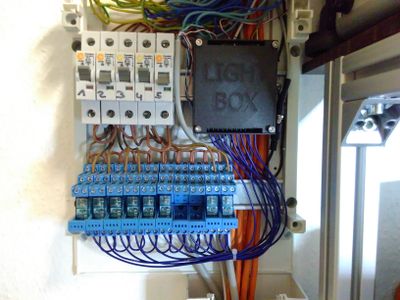Ueberschalter: Unterschied zwischen den Versionen
Weitere Optionen
Ollo (Diskussion | Beiträge) →Doku: Werkstatt hinzugefügt |
Ollo (Diskussion | Beiträge) Keine Bearbeitungszusammenfassung |
||
| Zeile 1: | Zeile 1: | ||
{{aktives Projekt|Kontakt=Ollo}} | {{aktives Projekt|Kontakt=Ollo}} | ||
[[Datei:SchaltschrankUeberschalterV2.jpg|400px|right|Schaltschrank Ueberschalter V2.0]] | |||
= Publikationen = | = Publikationen = | ||
Version vom 27. Januar 2019, 19:13 Uhr

Publikationen
Server
Hardware
- Raspberry Pi seriell stumm geschalten
- ioBoard Projekt auf Github
Das ioBoard wird über das UART des Raspberry Pis angesprochen. Die Kommunikation zum Raspberry erfolgt über Ethernet, es werden keine weiteren Schnittstellen benötigt.
Software
- raspbian (wheezy)
- ser2net
- lighttpd (optional für Webclient)
- Webserver-Projekt Unterordner web
Konfiguration
In der Konfigurationsdatei /etc/ser2net.conf von ser2net aktiviert man folgende Konfiguration. Alle weiteren können auskommentiert werden:
2001:raw:120:/dev/ttyAMA0:9600 NONE 1STOPBIT 8DATABITS -XONXOFF -LOCAL -RTSCTS
Webserver konfigurieren
$ cd /var/ $ sudo chown pi:pi www/ $ cd cd /var/www/ $ git clone https://github.com/C3MA/uberschalter $ cd uberschalter/web/ $ make
Aktualiseren der lighttpd Konfiguration zu folgender (Muss ggf. erst installiert werden):
server.modules = (
"mod_cgi",
"mod_access",
"mod_alias",
"mod_compress",
"mod_redirect",
# "mod_rewrite",
)
#server.document-root = "/var/www"
server.document-root = "/var/www/uberschalter/web/www"
server.upload-dirs = ( "/var/cache/lighttpd/uploads" )
server.errorlog = "/var/log/lighttpd/error.log"
server.pid-file = "/var/run/lighttpd.pid"
server.username = "www-data"
server.groupname = "www-data"
server.port = 80
index-file.names = ( "index.php", "index.html", "index.lighttpd.html" )
url.access-deny = ( "~", ".inc" )
static-file.exclude-extensions = ( ".php", ".pl", ".fcgi" )
compress.cache-dir = "/var/cache/lighttpd/compress/"
compress.filetype = ( "application/javascript", "text/css", "text/html", "text/plain" )
# default listening port for IPv6 falls back to the IPv4 port
include_shell "/usr/share/lighttpd/use-ipv6.pl " + server.port
include_shell "/usr/share/lighttpd/create-mime.assign.pl"
include_shell "/usr/share/lighttpd/include-conf-enabled.pl"
$HTTP["url"] =~ "/cgi-bin/" {
cgi.assign = ( "" => "" )
}
cgi.assign = (
".cgi" => ""
)
Client
Android
Web
Auf dem RaspberryPi läuft auch Webserver um die Lampen zu steuern: (Zu erreichen im Raum-Netzwerk unter lampi oder 10.23.42.140.)
-
Lamp Webinterface
Lampenpositionen
-
Lampenpositionen mit deren Identifikationsnummer
Mqtt
Doku
Folgende Stati werden in MQTT geschickt:
/room/light/3/command off /room/light/1/state on /room/light/2/state on /room/light/3/state off /room/light/4/state on /room/light/5/state on /room/light/6/state on /room/light/7/state on /room/light/8/state on /room/light/3/command off /room/light/3/command off /room/light/3/command on /room/light/3/state on
Linux Befehl:
$ mosquitto_sub -v -h 10.23.42.10 -t "/room/light/#"
Eine Lampe kann mit folgenden Schema geschalten werden: /room/light/<id>/command (on|off).
Unter Linux wurde das wie folgt getestet:
$ mosquitto_pub -h 10.23.42.10 -t "/room/light/3/command" -m "off" $ mosquitto_pub -h 10.23.42.10 -t "/room/light/3/command" -m "on"
Und hier das Sammel-Topic für die Werkstatt:
$ mosquitto_pub -h 10.23.42.10 -t "/room/light/w/command" -m "off" $ mosquitto_pub -h 10.23.42.10 -t "/room/light/w/command" -m "on"
Skript
#!/usr/bin/python
import mosquitto, os, socket, time
from threading import Thread
from time import gmtime, strftime
#File: /usr/local/sbin/light2mqtt.py
TCP_IP = '127.0.0.1'
TCP_PORT = 2001
BUFFER_SIZE = 1024
# Prometheus
#mqttBroker="10.23.42.31"
# BigBrother
mqttBroker="10.23.42.10"
mypid = os.getpid()
client = mosquitto.Mosquitto("RoomLights"+str(mypid))
# Zeit in Sekunden, in der die Lamen nicht geschaltet werden koennen (Schutz der Lampen und relais)
LAMPSLEEPTIME=5
pollerState = True
oldStates = {}
t = None
lampSleepProtection = {}
def processState(ls):
lightnr=1
global oldStates
global lampSleepProtection
werkstattState = "off"
for light in ls:
lightState = "on" if int(light) == 1 else "off"
if str(lightnr) in oldStates and lightState != oldStates[str(lightnr)]:
client.publish("/room/light/%s/state" % lightnr, lightState, 0, True)
print("%s Updated %s to %s" % (strftime("%Y-%m-%d %H:%M:%S", gmtime()), lightnr, lightState) )
# Zeit festlegen, solange die Lampe nicht mehr geschalten werden darf
lampSleepProtection[light] = int(time.time()) + LAMPSLEEPTIME
# Mindestens eine Lampe in der Werkstatt muss an sein
if lightnr == 5 or lightnr == 6:
werkstattState = "on" if lightState == "on" else werkstattState
lightnr+=1
# Aenderungen in der Werkstatt kommunizieren:
if 'w' in oldStates and werkstattState != oldStates['w']:
client.publish("/room/light/w/state", werkstattState, 0, True)
print("%s Updated Werkstatt state to %s" % (strftime("%Y-%m-%d %H:%M:%S", gmtime()), werkstattState) )
# Light ist das licht 1-6
# State ist h oder l
def switchLight(lights, state):
global lampSleepProtection
s = socket.socket(socket.AF_INET, socket.SOCK_STREAM)
s.connect((TCP_IP, TCP_PORT))
for l in lights:
if (l in lampSleepProtection and int(time.time()) < int(lampSleepProtection[l])):
print("%s Mqtt Command blocked for Lamp %s for %s seconds" % (strftime("%Y-%m-%d %H:%M:%S", gmtime()), l, str(lampSleepProtection[l] - int(time.time()) ) ))
else:
# Zeit festlegen, solange die Lampe nicht mehr geschalten werden darf
lampSleepProtection[l] = int(time.time()) + LAMPSLEEPTIME
s.send("ollpew%s%s" % (l, state))
time.sleep(0.2)
data = s.recv(BUFFER_SIZE)
s.close()
data = data.replace("\r", "").split("\n")
if len(data) > 3:
lightState = data[3].split(" ")[1]
print("%s Proccess via Mqtt for Lamp%s to %s" % (strftime("%Y-%m-%d %H:%M:%S", gmtime()), str(lights), state) )
processState(lightState)
else:
print("%s No answer from uC for Lamp%s to %s; only %s" % (strftime("%Y-%m-%d %H:%M:%S", gmtime()), str(lights), state, str(data)) )
def getStates():
s = socket.socket(socket.AF_INET, socket.SOCK_STREAM)
s.connect((TCP_IP, TCP_PORT))
s.send("ollpera")
time.sleep(0.2)
data = s.recv(BUFFER_SIZE)
s.close()
data = data.replace("\r", "").split("\n")
if len(data) > 2:
lightState = data[2].split(" ")[1]
print("%s Process by background thread" % strftime("%Y-%m-%d %H:%M:%S", gmtime()))
processState(lightState)
else:
print("%s No answer from uC getting its status; only %s" % (strftime("%Y-%m-%d %H:%M:%S", gmtime()), str(data)) )
def on_connect(rc):
#print("Connected with result code "+str(rc))
client.subscribe("/room/light/+/command")
client.subscribe("/room/light/+/state")
pollerState = True
def on_message(userdata, msg):
global oldStates
topic = msg.topic.strip("/").split("/")
lightNr = str(topic[2])
message = str(msg.payload)
if (topic[3] == "command"):
if (lightNr == "w" or int(lightNr) >= 1 and int(lightNr) <= 6) and message in ["on", "off"]:
lightState = "l" if message == "off" else "h"
# Lichter in Array gruppieren fuer die Werkstatt
if (lightNr == "w"):
lights = [5, 6]
else: # Sonst array mit einem Licht erstellen
lights = [ int(lightNr) ]
switchLight(lights, lightState)
elif (topic[3] == "state"):
# Nicht die Werkstatt aktualieren, das passiwert in getStates()
try:
if (lightNr == "w" or int(lightNr) >= 1 and int(lightNr) <= 6):
oldStates[lightNr] = message
except ValueError:
pass
def on_disconnect(userdata):
pollerState = False
#print "Disconnect"
def statePoller():
while True:
if pollerState:
getStates()
# Update the button only all half minutes
time.sleep(30)
client.on_connect = on_connect
client.on_message = on_message
client.on_disconnect = on_disconnect
client.will_set('/room/light/daemon/state', 'offline', 0, True)
t = Thread(target=statePoller)
t.start()
while True:
# print "Connect..."
client.connect(mqttBroker, 1883, 60, True)
client.publish('/room/light/daemon/state', 'online', 0, True)
while client.loop() == 0:
pass
# print "Reconnecting..."
time.sleep(60)
Autostart im Raspberry: Folgende Zeile in /etc/rc.local einfügen: (vor dem exit 0 wenn vorhanden)
# Start the monster deamon to rule the world /usr/bin/python /usr/local/sbin/light2mqtt.py &


